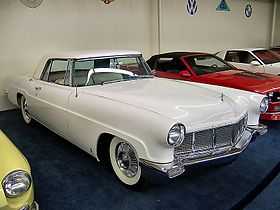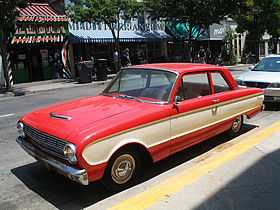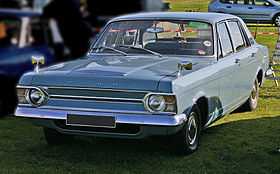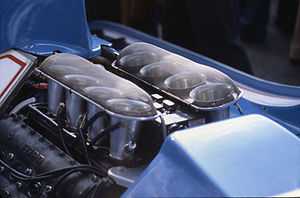Harley Copp
Harley F. Copp (born 1922 in Kansas - died October 11, 1991 in San Clemente, California),[1] was a car designer and automotive safety consultant.
A 35-year veteran of the Ford Motor Company, Copp made his name leading the engineering design of various Ford products of the 1950s including the Continental Mark II in 1953 and the Falcon of 1959. Assigned to create the new Ford Engineering design unit in Brentwood, Essex in England, he led the design and engineering efforts around the Ford GT40 and the Ford Cosworth DFV race engine.
On his return to the United States, Copp had an internal view of the design work associated with the Ford Pinto, the production of which he disagreed with once the well documented safety problems were known. Copp resultantly resigned from Ford, and his subsequent articles and critic was successfully taken up by Ralph Nader. Copp spent the rest of his career as an automotive safety consultant, advising both automotive companies and legislators on suitable design and test solutions.
Copp died in San Clemente, California from complications from a stroke.[1]
Biography
Copp was born in Kansas, but grew up in Dearborn, Michigan.[1] After graduating from the Edison Institute of Technology he joined the Ford Motor Company as an engineer,[1] working on new car designs. As a side project, Copp backed and engineered Ford's successful entry into NASCAR in the 1950s.[2]
Ford Continental

Copp first came to the fore of car design, when he was chosen as part of the team to revive the Continental as a superior and standalone up-market brand aside from Lincoln, to compete with General Motors Cadillac and Chrysler's DeSoto brands.
Having considered using an outside design team, Ford turned inside to their own Special Products Division. In Fall 1952, they designated John Reinhart as chief stylist, Gordon Buehrig as the chief body engineer assisted by Robert McGuffey Thomas; and Copp as chief engineer.[3]
Ford had wanted to use unibody technology, but Copp argued against such a choice for a high-brand/low volume model, which was required to be delivered into sale in such a short time scale.[4]
Handbuilt and resultantly expensive at USD10,000 on launch, the quickly redesigned 1959 MkIII was cheaper at $6,000, mostly because it recycled Lincoln parts and technology. The result was that the two products were difficult to differentiate within the customers mind, and resulted in the Continental marque being re-absorbed by Lincoln.[5]
Ford Falcon

By the late 1950s, Ford wanted to reduce its marketing spend on supplementary brands, and appeal to a wider number of car buyers. They commissioned a team to create what by American standards of the time a small car, but elsewhere in the world would be considered a mid-size car. With room for six passengers in reasonable comfort, to keep the price down Copp engineered a unibody, keeping suspension standard and sourced from Ford's existing parts bin: coil springs in front, leaf springs in the rear, drum brakes all round. It was powered by a small, lightweight 90 hp (67 kW), 144 CID (2.4 L) straight-6 with a single-barrel carburettor. A three-speed manual column shift was standard with the two-speed Ford-O-Matic automatic optionally available.
On launch, the first generation Falcon was available as a two and four-door sedans, two or four-door station wagons, and the Ranchero car-based pickup, transferred onto the Falcon platform for 1960 from the Fairlane. A Mercury derivative, the Mercury Comet, originally intended for the defunct Edsel marque, was launched in the US midway through the 1960 model year.
The market shift which spurred the development of the Falcon precipitated the demise of several well-established marques in the late-1950s and early-1960s. Besides the infamous tale of the Edsel, the Nash, Hudson, DeSoto and Packard nameplates all disappeared from the marketplace.
Ford UK and Brentwood
After the launch of the 1958 Continental and engineering for the 1960 Lincoln Continental, Copp left to set up a special vehicles engineering department in Europe. Ford had chosen Brentwood, Essex in England for the site, and Copp became Vice President Engineering, Ford of Britain.[6]
MkIV Zephyr

In 1961, the first project Copp became involved in was project "Panda", which became the MkIV Zephyr/Zodiac range. As the car used the new V-series engines, the then traditional long bonnet concept created a problem until Copp required that the car was both larger and had more internal space, and came up with the idea of placing the spare wheel ahead of the radiator on an angle.[7] The result was a vehicle of similar dimensions to the North American Ford Fairlane. Unfortunately, as the MkIV carried over so little engineering from the MkIII, Copp's insistence on independent rear suspension resulted in an alarming “tuck-under” of the outer rear wheel when cornering with the back seats empty. Neat “bow-back” styling made the capacious boot look deceptively short, but the large expanse of bonnet was unkindly likened to the landing deck of an aircraft carrier by some journalists!
Cosworth DFV
As Vice President Engineering, Ford of Britain, Copp oversaw the development of the Ford GT40 by Lola. However, his key input was on the Ford Cosworth DFV.
Colin Chapman's Lotus cars had until that point relied on power from fast revving Coventry Climax engines, but with the change in Formula One regulations to three litre capacity from 1966, Coventry Climax decided for business reasons not to develop a large capacity engine. Chapman had approach the fledgling Cosworth group, with Keith Duckworth commenting that he could produce a competitive three litre engine, given a development budget of £100,000.[8]
Chapman approach Ford and also David Brown of Aston Martin, each without initial success. Chapman's friend and Ford Great Britain's PR director Walter Hayes arranged diner for Chapman with Copp.[2] Hayes and Copp developed a business plan, which was backed by Ford UK's new chairman Stanley Gillen, and approved by Ford's Detroit head office as a two-part plan - stage one would produce a four-cylinder twin-cam engine for Formula Two; by May 1967, stage two would produce a V-8 Formula One unit. In return, Chapman agreed to engineer "specials" for Ford, the first of which was 1963's Lotus Cortina.[2]
Revealed by Hayes in a PR launch in Detroit at the end of 1965, the Ford Cosworth DFV won its first race - the Dutch Grand Prix on 4 June 1967, in a Lotus 49 driven by Jim Clark. Graham Hill was in the team was at the specific request of Ford and Hayes, who wanted to be sure that a strong driving cadre would be seated ahead of their engines.[2]

Initially, the agreement between Ford, Cosworth and Lotus was binding on all parties, and Ford as the funder had no plans to sell or hire the DFV to any other teams. However, it occurred to Hayes that there was no competition - the Ferrari was underpowered; the BRM complex and too heavy; the unreliable Maserati; Brabham was powered by the Oldsmobile-derived V8 Repco ; the overweight Honda; while Dan Gurney's Eagle Weslake was beautiful, powerful and sleek, but often unreliable.[9] Hayes concluded that Ford's name could become tarnished, and that they should agree to use the unit in other teams, and hence potentially dominate Formula One. Chapman, on the back of the pairs long friendship agreed, and Hayes could release the DFV initially to revival French team Matra, headed by Ken Tyrrell with Jackie Stewart as a driver.[9]
Still the most successful Grand Prix engine ever, sixteen years later it was still taking the chequered flag - a DFV-powered Tyrrell Racing car won the 1983 Detroit Grand Prix, the engine's 155th race victory: with the Ford logo branded on the side of every one.
At the start of the DFV project, Hayes told Henry Ford II that he thought the DFV engine was "fairly likely" to win a World Championship.[2] In 1997 a group of people gathered at Donington Park to commemorate the DFV's 30th anniversary. Jackie Stewart said a few words, making comments on an engine which had made him as well as Graham Hill, Jochen Rindt, Emerson Fittipaldi, James Hunt, Mario Andretti, Alan Jones, Nelson Piquet and Keke Rosberg. It had also brought championships to teams: Lotus, Matra, Tyrrell, McLaren and WilliamsF1; and won races for Hesketh, March, Penske, Shadow and Wolf.[9]
Ford Cortina Mk3

In the late 1960s, Ford set about developing a third-generation Cortina, which would be produced in higher volumes than before. It was the last European car engineered by Copp before he returned to Detroit.[10]
The Mark III Detroit-inspired "coke bottle"-shaped Cortina TC was a hit amongst fleet buyers. It replaced both the Cortina Mark II and the larger, more expensive Ford Corsair by offering more trim levels and the option of larger engines than the Mark II.
The Mk II's MacPherson strut front suspension was replaced with more conventional double A-arm suspension to give the car a soft 'freeway' ride, which gave the larger engines distinct understeer.
Ford Pinto

In 1968, Copp returned to North America to head-up Ford's crash testing program team. By this time, the manufacturer preferred large American automobiles were losing market share to smaller more fuel efficient and reliable Japanese imports. As a result, CEO of the Ford Lee Iacocca wanted a 1971 model that weighed less than 2,000 pounds and that would be priced at less than $2,000.[11]
The first Ford Pinto was delivered in September 1970 at a retail cost of $1850, but to achieve the time scale the car had had to be designed and produced in 25 months, rather than the then usual 43 months for a new car line. Although inline with safety certification of the National Highway Traffic Safety Administration, front end testing had been completed, to save time rear-end collision testing was not undertaken until after launch, although Ford engineers knew that testing for rear-end impact was a standard safety procedure.
After rear end testing by Copp's team proved there was a problem from the bolts attaching the rear bumper to the body, and those protruding from the differential, would in an accident above 20 miles per hour (32 km/h) penetrate the gas tank, Copp issued an internal memo suggesting rectification measures.
Before final sign-off of the 1972 Pinto, in April 1971 Harold MacDonald, Ford Vice President of Car Engineering, chaired a product review meeting around a report from Ford engineers. The recommendation suggested deferring from 1974 to 1976 the incorporation into all Ford cars of either a shock absorbent "flak suit" to protect the fuel tank at a cost of $4 per car, or a nylon bladder within the tank at a cost of $5.25 to $8 per car. Agreeing the decision would allow Ford to realize a savings of $10.9 million. MacDonald agreed the reports recommendation, and hence left the Pinto exposed to rear end collisions.
Grimshaw v. Ford Motor Co.
In 1972, a rear end accident occurred in California, that killed Pinto occupant Lilly Gray and severely burned 13-year old Richard Grimshaw. The accident resulted in the court case Grimshaw v. Ford Motor Co.,[12] in which Copp testified. Due to his concerns, which he had both vocalised and written about internally, Copp was effectively fired by being forced to take early retirement just before the case came to review. Acting on a tip from a Ford employee moonlighting as a Detroit cab driver, Copp was tracked down and agreed to testify.[13] Appearing an as independent automotive safety consultant, Copp testified that the highest level of Ford's management made the decision to go forward with the production of the Pinto, knowing that the fuel tank was vulnerable to puncture and rupture at low impact speeds, knowing that these "fixes" were feasible at nominal cost.[14] The California Court of Appeal for the Fourth Appellate District upheld compensatory damages of $2.5 million and punitive damages of $3.5 million against Ford, in part because Ford had been aware of the design defects before production but had decided against changing the design.
In June 1978, after it was required to do so by the National Highway Traffic Safety Administration (NHTSA), Ford recalled all 1.4 million 1971 through 1976 Pintos for fuel system modification. By the time of the recall, Pinto fuel-fed fires had killed at least 27 people and injured many others.[15]
Ford appealed the decision right up to the United States Supreme Court in 1981, but were denied grounds on which to appeal the then growing evidence and their own actions in rectification.[16] Kennedy, who had replaced Copp as Head of Testing, had ordered a cost-benefit analysis, as a result of which Ford decided it would be cheaper to pay off possible lawsuits for resulting deaths. Mother Jones magazine obtained a copy of what became known as the Ford Pinto memo, which said Ford had used to compare the cost of an $11 repair against the cost of paying off potential lawsuits.[17]
In Atlanta GA in February 1993, a drunk driver struck 17-year-old Shannon Moseley’s Ford truck in the side, which started a gas tank fire, and resulted in the death of Moseley. Ronald E. Elwell, a former Ford automotive safety engineer who had testified on behalf of Ford in more than 15 previous cases that Pinto's were safe, gave the jury the test information that Ford seen showing Pinto's were not safe. The unanimous jury blamed Ford, and awarded $4.2 million in actual damages and $101 million in punitive damages to Moseley’s parents.[18]
Safety consultant
After the Ford into case, Copp took up the baton for compulsory vehicle testing, an issue that was picked up through his work with Ralph Nader's Center for Auto Safety.
Copp spent the rest of his career as an automotive safety consultant, advising both automotive companies and legislators on suitable design and test solutions.
Copp died in San Clemente, California from complications from a stroke.[1]
References
- Douglas Birsch, John H. Fielder. The Ford Pinto case: a study in applied ethics, business, and technology - Page58.
- Richard T. De George. Ethical Responsibilities of Engineers in Large Organizations: The Pinto Case.
- Business and Professional Ethics Journal, 1, no. 1 (1981), pp. 1–14.
- Lee P. Strobel (1980). Reckless Homicide? Ford's Pinto Trial. (South Bend, Ind. And Books.
- Mark Dowie (September–October 1977). Pinto Madness. Mother Jones. pp. 24–28.
- Matthew T. Lee and M. David Ermann. Pinto 'Madness' as a Flawed Landmark Narrative: An Organizational and Network Analysis. Social Problems 46 (1), 1999, pp. 30–47.
Notes
- ↑ 1.0 1.1 1.2 1.3 1.4 "Harley F Copp". Los Angeles Times. 1991-10-11. Retrieved 2010-05-18.
- ↑ 2.0 2.1 2.2 2.3 2.4 "Walter Hayes: Racing's Ultimate Insider". Autosport.
- ↑ http://www.autolife.umd.umich.edu/Design/Thomas_interview.htm
- ↑ Thomas E. Bonsall. The Lincoln story: the postwar years. Retrieved 2010-05-18.
- ↑ http://www.uniquecarsandparts.com.au/auto_manufacturers_c.htm
- ↑ http://www.autolife.umd.umich.edu/Design/Najjar3_interview.htm
- ↑ http://web.archive.org/web/20091027125933/http://www.geocities.com/motorcity/garage/7266/magapr03.html
- ↑ http://www.hrpworld.com/index.cfm?template=news&news_id=2295
- ↑ 9.0 9.1 9.2 http://www.grandprix.com/ft/ftdt018.html
- ↑ http://tawnypaul.mysite.wanadoo-members.co.uk/page4.html
- ↑ http://www.safarix.com/0130991635/ch12
- ↑ "Grimshaw v. Ford Motor Co.".
- ↑ http://www.ocbar.org/dmoct01.htm
- ↑ Douglas Birsch, John H. Fielder. The Ford Pinto case: a study in applied ethics, business, and technology - Page58. Retrieved 2010-05-18.
- ↑ http://www.citizen.org/congress/civjus/tort/articles.cfm?ID=919
- ↑ "Civ. No. 20095, Grimshaw v. Ford Motor Co.". JunkCarMuseum.com. Retrieved 2011-01-15.
- ↑ http://www.calbaptist.edu/dskubik/pinto.htm Ford Pinto Memo
- ↑ http://www.caoc.com.cn/FileContent.aspx?id=384